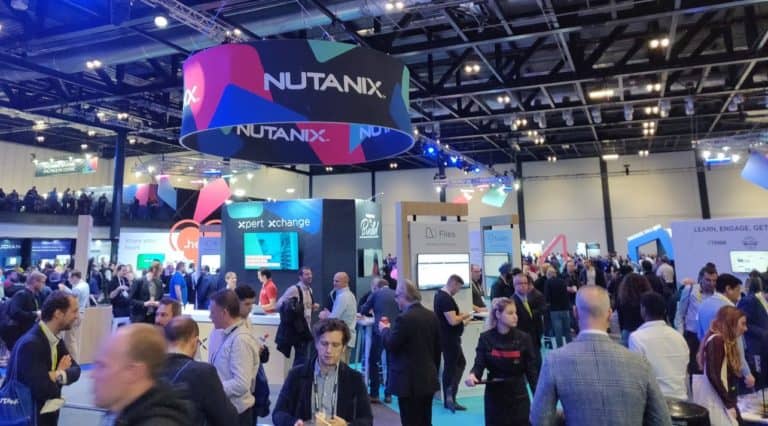After ten years of dreaming, building and believing, the Californian Nutanix has firmly established itself. The company that started out with the virtualisation of storage has grown into a tech giant with 5000 employees and 15,000 customers worldwide. Over the years, the Hyper-Converged Infrastructure (HCI) concept has evolved, but the principle of adherence has remained the same. Relieve the customer of their worries and make enterprise IT as simple as possible. Visible IT, invisible clouds are the buzz words. This may involve the hybrid cloud, i.e. both the public cloud and on-premise.
Nowadays, not only storage is virtualised, but compute has also been elevated to a managed cloud service. An empty enterprise data centre and IT that operates from a private and/or public cloud; this is the dream of Nutanix founder and CEO Dheeraj Pandey, to completely relieve customers of their worries and make them agnostic for providers of hardware, software and services. Vendor lock-in is a word that does not exist in that vision.
Every year the European partners of Nutanix meet at the .Next conference. This year, Copenhagen was chosen as the operating base. The motto of the conference is: “All together now”. A reference to the ultimate fusion of hardware, software and services in the Nutanix Enterprise Cloud OS. In the near future, the slogan will appear in the media as the primary communicative expression. By “All together now” Nutanix means that Enterprise Cloud OS ensures that all IT components work together seamlessly under one umbrella and via one dashboard. This completely relieves the customer: “Invisible cloud and visible IT”. The service is also available as a managed service through service providers.
Stabilising the operating system
Pandey had two important announcements during the conference. He believes that IT should be as stable and normal as water from the tap and electricity from the socket. Resilience is an important element in the quality of service. Much is currently being invested in making the control system, and the components that are part of it, more stable than they already are.
Dutch channel manager Sunil Dutt indicates that a lot of work is being done on several 2.0 versions of the elements. “A commitment to the customer that improvements now drive innovation. The customers see us putting energy into further stabilizing the services, then adding several lots to the tribe. It fits in with the ambition to add more resilience,” says Dutt.
Due to the rapid expansion, customers became a little more cautious. This was also reflected in the financial sentiment. The stock exchange expected growth figures of 75 percent year on year. This was unrealistic and resulted in falling stocks. Nutanix sees the new strategy as one of stable growth (45 percent) with prospects for the future.
Dutt is also clear about the cloud strategy: “The hybrid cloud is temporary, the invisible public cloud will become the standard. Eventually, Nutanix will become a complete service provider based on cloud technology.”
Shift towards a subscription model
Furthermore, as the second major change, the financial model is undergoing a major transformation. As is the case with many providers, perpetual licenses make way for subscriptions. As a result, the financial obligations of companies are shifting from fixed CAPEX to flexible OPEX.
IT suppliers with a subscription model, in turn, get a very predictable turnover, so that financial targets can be managed better and revenue streams show more continuity. The transition is going fast, according to Pandey more than 70 percent of the Nutanix customers have already chosen this financial variant.
Hardware is becoming less and less prominent. Dutt cites the collaboration with HPE, whereby customers of HPE hardware are provided with the opportunity to use Nutanix Enterprise Cloud OS on the hardware of their choice.
Why is the Nutanix concept successful?
Nutanix manifests itself as a comprehensive enterprise OS. One software layer that protects all enterprise IT processes from the user. In the PC world, Windows solves the differences between the hardware of different providers, while Nutanix does this for enterprise IT. Cloud services, on-prem or public, hypervisors and applications all come together in one front-end.
Beam plays a central role in the concept. This function integrates even more tightly and will now also better balance the use of different (hybrid) cloud services. By shifting workloads, cost optimisation is achieved. In this way, customers can be sure that they are using their infrastructure at the cutting edge of their knowledge.
The next step to the cloud transformation comes from VDI (virtual desktop infrastructure). That is why we dare to say that within ten years, VDI will only be a cloud service. Microsoft, VMware and Citrix are already planning this, so it is expected that Microsoft will completely convert its Windows environment to a VDI solution. Nutanix’ own solution for VDI is Frame. The company behind Frame was recently acquired and is already integrated in the Nutanix portfolio. Using Frame does not require any on-premises installations and virtualises the desktop entirely from the cloud. This should distinguish Frame from competing products, which sometimes require complex on-premise integration. The complex installation process no longer occupies the customer, Dutt only sees the simple user surface.
Much is also changing on the hypervisor side. Both the Nutanix hypervisor (AHV) and the VMware hypervisor (ESX) can now be used next to each other, and a failover is planned. This has further increased the resilience of the platform. Apart from the fact that AHV is offered as a free service to the customer, the hypervisor contributes to Nutanix’s ultimate goal: to relieve the customer of his worries.
